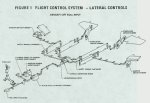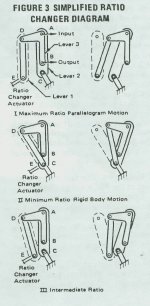F-15 Flight Control
System
Part III - Lateral Control
LATERAL TRIM
Referring to Figure 1, follow the lateral linkage from the control stick to the lateral feel trim actuator. Note that the actuator is mounted in parallel with the overall control linkage. This is just a simple way to say that the system linkages are not shortened or lengthened; the trim actuator merely moves the total system.

The feel trim actuator performs two equally important tasks: it establishes the zero force position of the control stick and provides the pilot with an artificial feeling of maneuvering stick force. The zero force or "hands-off-stick" position may be varied as the pilot requires by activation of the stick grip button. The trim motor may also be repositioned through operation of the takeoff trim button which drives the actuator to a preset neutral position, streamlining the control surfaces.
Simultaneous with actuator travel, electrical signals are generated by a pair of linear voltage differential transformers (LVDT).
Outputs from these level detectors are supplied to the takeoff trim indicator light logic in the CAS computers. When this logic sees the same voltage level from all three channels, (roll, pitch, and yaw), the takeoff trim light illuminates, indicating to the pilot that his surface controls are properly positioned for takeoff. These LVDT signals serve yet another function in advising the CAS roll channel of changes in trim commands so that the CAS doesn't defeat pilot-inserted trim. Lateral artificial feel force is provided to the pilot by dual spring gradients within the actuator. For the first inch of lateral stick travel, the force is 5 pounds (plus a 1.0 pound breakout); the gradient then drops to 3.67 pounds per inch of additional stick deflection. The dual spring gradient helps reduce lateral stick sensitivity around neutral. The LVDT signals and CAS circuits are dual redundant, providing a fail-safe operation in which the system shuts down to prevent runaway trim.
ROLL LINKAGE
As it leaves the lateral feel trim actuator, the linkage takes two paths. The first path travels to the ARI on the right-hand side of the airframe. As we discussed in Part II of this series, this input supplies the lateral intelligence to the ARI. The second path continues down the left side of the aircraft to the PRCA which is the "brains" of the F-15 mechanical control system. Figure 2 is a block diagram of the PRCA and shows the data flow within the roll channel of the PRCA.

Roll Ratio Changer -- The roll ratio
changer, within the PRCA, contains the dual mechanical linkage
required to vary the stick-to-aileron/differential stabilators
gearing at a ratio of 4:1. Figure 3 explains how a parallelogram
ratio changer does its work.

Diagram I shows the ratio changer actuator at maximum ratio as indicated by distances D to A and E to C being identical. Pilot stick inputs to point A displaces the output B by the same amount; that is, a 1:1 ratio. In diagram II, note that the ratio changer has been fully extended, placing pivots E and C over one another. Stick inputs to point A can rotate the linkages about E and C with only a small amount of output displacement for a ratio of 4:1. Diagram III shows an intermediate ratio. In this case, pivot E of the ratio changer actuator can be called upon to vary the ratios as dictated by the air data information fed to it, or by longitudinal control system position.
Presuming you've digested at least a part of that, let's press on. Within the ratio changer section, you'll find a ratio lock. This drives the ratio changer mechanism to the failed ratio in event of a loss of hydraulic supply pressure. In addition, the pilot may select the emergency mode to isolate a suspected malfunction. He does so by placing the Roll Ratio switch to EMERG(ency) which removes hydraulic pressure to the roll ratio channel of the PRCA. The roll ratio repositions itself to about one-half ratio in emergency, or 10° of aileron plus 3° differential stabilator which is more than adequate for normal flight and safe return to base. During emergency operation of the roll channel of the PRCA, the Master Caution light and Roll Ratio telepanel light will illuminate warning the pilot of a problem. Lateral control stick inputs into the PRCA during the transition time are quite heavy

